This summer, I headed off to Australia with a spring in my step and a new Garmin Forerunner 735XT on my wrist. It had been a winter of discontent , disappointment and disconnection, but I had decided that by autumn, I would branch out into new sports and activities and leave my troubles and negative thoughts behind.
Armed with the Garmin Forerunner 735XT, I was equipped to track several new activities in addition to the staples of outdoor and indoor running, cycling and swimming which are more than adequately tracked by almost every other Garmin Forerunner watch.
These included Rowing, Stand Up Paddle (SUP) boarding and Hiking. All activities that I hoped to undertake while on my Australian travels.
There is also the option of adding other activity profiles, such as Strength and Cardio, but these basically operate like a stopwatch with heart rate based calorie burn, which don’t, in my opinion, add much value, although you can download HIIT training apps, which could be fun (please note that perceptions of what constitutes fun may vary).
The watch itself is smaller than the Forerunner 620 and similar in shape and size to the Forerunner 235. This makes for a comfortable fit and more likely to be “borrowed” by my training partner and partner in life, Teresa. It is quite light and given my knack for falling off of bikes, I have concerns about how durable the plastic casing and screen are. My first 620 (it was stolen during a burglary) suffered a few scrapes and some might prefer a more rugged watch, such as the new Suunto Spartan Ultra, but I do like how light it is and the fact that I can customise it and wear it as an everyday watch (more on that later) at work.
It also lacks the touch screen ability of the Forerunner 620, but I have a confession. While I loved my 620, I prefer using buttons. More reliable, especially in wet conditions (I do live in Glasgow) and a slightly faster and more accurate response than the touch screen , although that might be down to my fat fingers.
Outdoor Swimming with the Garmin 735XT
While in Oz, I went swimming in oceans, lakes, creeks and even under a waterfall and can attest to it being waterproof (and shockproof seemingly). The optical heart rate monitor doesn’t work in water, but Garmin do provide a chest strap for swimmers and another for triathletes with the Tri Bundle. I never tested these as I had left them at home, but when I start my swimming lessons (pool and sea), I will use this to measure my performance and progress.
Currently, I am more of a try-athlete than a triathlete, so the Forerunner 735XT is probably a tad advanced for my needs, but the Ironman within me is eager to test it in triathlons and I did manage to test while hiking through a few rainforests and on a kayak in the Whitsunday Islands
Kayaking with the Forerunner 735XT
The activity profile on the Forerunner 735XT is actually for rowing and I am not sure just how universal stroke speed and distance are, but on reviewing my performance back on land and comparing it against average kayaking metrics, the numbers seemed about right. For someone not very good at kayaking, that is.
And here is my main issue with the all singing (only activity it doesn’t measure) and all dancing Forerunner 735XT.
Post kayak or row, I love looking at the stats, charts and maps on both the Forerunner 735XT and the Garmin Connect App on my mobile phone and reflecting on my performance. While running, I can lift my arm and see how I am performing in real time, and make adjustments, but just try that while kayaking (and even swimming). You are dependent on two arms and monitoring your performance is impossible, using only the watch (feel free to correct me) without interrupting your flow.
However, the GPS does certainly work well enough, even at sea. It is very quick at acquiring satellites and much faster than my old Forerunner 620. I especially like the Garmin Connect maps.
Hiking with the Forerunner 735XT
In Hiking mode, it also adds elevation and as we climbed Mt Ngungun in the Glasshouse Mountains (read my post about it) and Mt Cannibal (given the Australian tradition of naming every place literally such as “To The Beach Road”, I was relieved to find it was clear of cannibals ), my boys were elated to hear at regular intervals how high we were climbing. One caveat worth noting is that the Forerunner 735XT relies on GPS. For some reason, known only to Garmin, it doesn’t have a barometric altimeter that you can find in the likes of the Vivoactive HR .
In addition to measuring our elevation, it also measures distance, pace, calories burned and of course heart rate, which seemed to elevate in pace with our ascent of Dunk Island. The dips were undoubtedly selfie and scenery stops. Not rests. Honest.
And that brings us neatly to the wrist based optical heart rate monitor (hrm). For me, chest straps found on sports watches are a pain. Literally. They are often too tight and I have often found it difficult to keep them in place. The addition of an optical hrm attracted me to both the Forerunner 235 and 735XT and there is something addictive about checking your heart rate while walking to work, climbing stairs, watching television and even while sitting on the loo. Possibly too much information, but I was only doing so for research purposes. Honest.
But the optical monitors are not without their detractors. Fitbit are currently battling a class action lawsuit for the inaccuracy of their optical heart rate monitor watches and I do have some reservations about the Garmin Elevate system. It is a proprietary technology and over the courses of several updates, Garmin claim that it has become more accurate and for the majority of time, it does seem to be. I have a very low resting heart rate and recover relatively quickly from exertion (it must be all the yoga and meditating) and the Forerunner 735XT seems to be unable to react accurately to sudden changes in heart rate, although it does eventually respond and for my purposes , the readings are accurate enough. While wearing it 24/7, I really like how it uses my heart rate to determine my daily basal metabolic rate. I.E. how many calories I burn each day (otherwise referred to as how much food I can eat in a day).
You become addicted to checking if your heart is still beating
I also quite like the customisable watch faces via Garmin IQ (their App centre) and the smart notifications that show me weather forecasts, social media updates, and even text messages and incoming calls (handy at work). However, these are also available on the Forerunners 235 and 635, and on their own, they are not a reason to upgrade to the Forerunner 735XT. However, the watch does come into its own with some key and rather exciting features.
The Forerunner 735XT is the only Garmin watch order viagra
that supports the Garmin Varia range and having picked up the Vision In-Sight display headset, I can confirm that they pair together quickly. As I train for triathlons and get out on my bikes more, I will fully test the Vision and report back.
The Forerunner 735XT also improves upon the 235 by adding a function that would please my Chi Running coach (see my review of Chi Running).
A Metronome.
I am guilty of a long stride (even with my short legs) and a low cadence and the Metronome tool is set to pulse at the recommended 180 steps per minute, although this can be tailored to each runner. This helps you run at a more efficient pace.
For the sports scientists among you, the Forerunner 735XT is equipped with all manner of performance indicators. From the standard training tools, race predictor, VO2 max (premium Forerunners) and recovery adviser to more advanced Lactate Threshold (requires the chest strap) and Functional Threshold Power readings. I will be honest, these mean little to me at the moment, but I intend on finding out.
You might think that all of these functions and the constant use of GPS, heart rate and bluetooth might be battery intensive and in comparison to the seemingly never ending battery of the Garmin Vivofit, it is. While away for four weeks, and using the heart rate and GPS, I have charged it three times with a very quick charge time. I should point out that Garmin state that it will last 14hrs in full race mode, so any budding Ironmen might want to consider their expected finishing times and an alternative watch, such as the Fenix 3.
However, the Garmin Forerunner 735XT is a stunning sports watch that combines many of the best features of Garmin’s Forerunner and Fenix ranges and it equally works well as a physical activity tracker (like other models, it reminds you to move) and smart watch.
All of this doesn’t come cheap (Garmin Forerunner 735XT Tri Bundle costs £435 at Wiggle , but you can pick up the Run Bundle for £335 at Millets) and for the average runner or cyclist, I might recommend the less expensive options of the Forerunner 235 or Vivoactive HR, but then, who wants to be average and who would much rather be an Ironman (or at least a half Ironman)?
The Garmin Forerunner 735XT is a watch for Triathletes and Try-Athletes. It is the watch for me.
Disclaimer. Garmin provided a Forerunner 735XT for this review, but I loved it so much, I bought one for myself.




















2 comments
Really interesting post! I have never thought of getting a sports performance watch but I’ve really started getting into fitness lately so it might be something to look into!
http://www.miniaturemilk.co.uk / imogen
Hi Imogen, I am a bit of a gadget geek and a Garmin fanboy, but the Garmin platform is excellent and the watches are stylish and functional. The 735XT is a he investment and I am looking to my future as a triathlete. If you are looking for an excellent multisport watch, then the Garmin Vivoactive HR is excellent value and as an alternative the Tom Tom Runner 2 is great if you like music. It is however a bit ugly and can be cumbersome to use.